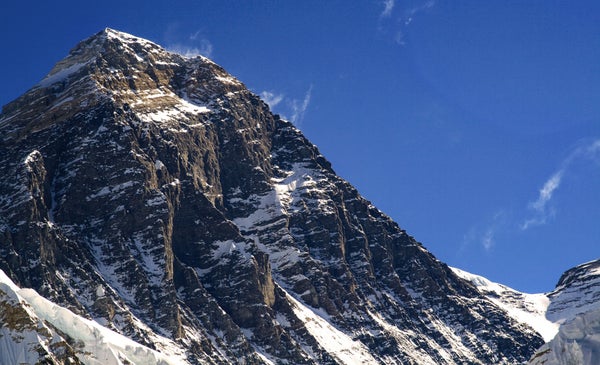The climbing community is buzzing with news that Mount Everest’s notorious Hillary Step, a nearly vertical rock face just below the summit, may have collapsed.
On May 17 British climber Tim Mosedale posted on social media a photograph of a rock outcropping, saying: “It’s official—The Hillary Step is no more.” This reignited chatter from last year speculating that the 2015 Nepal earthquake, which killed about 9,000 people including 19 climbers on Everest, also altered the shape of that part of the mountain. But some Sherpas, including Ang Tshering Sherpa, president of the Nepal Mountaineering Association, told the BBC Mosedale is mistaken and the rocky feature is unchanged.
Once thought to be impossible to scale, the Hillary Step—a rocky rise jutting out of a narrow ridge with steep drop-offs of thousands of feet on either side—is the unavoidable final technical challenge before reaching the top of the mountain. The rock feature is named after Sir Edmund Hillary; he and Nepalese Sherpa Tenzing Norgay were the first people known to have successfully summited Everest, in 1953. The step is part of history, says climber and geologist Ulyana Horodyskyj, who specializes in glaciology and earned her PhD at the University of Colorado Boulder. “That’s why it’s an interesting conversation to see if it has changed,” she explains. “That [feature] is—or was—seen as your last true test before reaching the top.” Horodyskyj attempted Everest in 2014, shortly before the mountain’s deadliest avalanche killed 16 Sherpas, including one of her team members. She made it as far as Everest Base Camp.
On supporting science journalism
If you're enjoying this article, consider supporting our award-winning journalism by subscribing. By purchasing a subscription you are helping to ensure the future of impactful stories about the discoveries and ideas shaping our world today.
Horodyskyj says Mosedale’s photo of the step looks like something is different from images taken in past years, but she cannot be certain without photos taken more precisely from the same angle. The high winds and altitude (some 28,000 feet, or 8,530 meters) make it too difficult for a helicopter to fly safely and confirm the change. She expects better images of the scene to surface in the coming days, as other climbers reach that stage of their ascent in the middle of the climbing season.
Even with the perfect picture, however, the amount of snow on the step varies from year to year, making it tough to know for sure if—and when—the topography has truly changed. “It could have happened during the earthquake or after,” Horodyskyj says. “Sometimes things fall immediately, and sometimes they crack and then eventually fall off.” The 2015 climbing season was canceled after that year’s temblor, and 2016 brought too much snow to confirm whether rumors of an altered landscape had any basis, despite hundreds of climbers reaching the summit. (If the step had indeed collapsed, it would be a somewhat flatter ridge without a rock face. Climbers could still traverse it.)
But Horodyskyj says a change or collapse involving the Hillary Step could be dangerous for climbers, because it could expose potentially unstable ground. Without the rock face, “maybe you get the impression that it’s safer” if the climb along the ridge to the summit was flatter, she says. “But it might not be stable yet. It’s still settling post-earthquake.”
Melting snow could further expose wobbly terrain. Right now, Horodyskyj says, a snow ridge next to the Hillary Step diverts some climbers over the rocks, easing a dangerous climbing-season traffic bottleneck that often keeps mountaineers waiting in the cold—with dwindling oxygen supplies—to use the fixed ropes installed on the step. That snow might not be there in coming years, in part due to climate change, Horodyskyj says. Much of her research is on “black carbon”—sooty pollution that settles on snowy mountainsides and glaciers, reducing the surface’s reflectivity and accelerating melting by absorbing more sunlight. Because it is tough to get to the summit, she says she and her colleagues do not yet have enough samples to know what effect black carbon has at that altitude. She hopes to attempt another climb soon, but will not make it this season.
Horodyskyj, an experienced mountaineer, outlines a number of geologic signs that would confirm the condition of the Hillary Step. “I’d be looking for evidence of fresh rock fractures, and looking at the color of rocks,” she says. “When rocks are exposed to the elements, they get weathered. But when you break rocks open, they are much fresher. That would be a great way to tell.” Further, she adds, the rocks might currently be under too much snow to study: “I guess the true story will come out once the snow reveals its secrets.”
